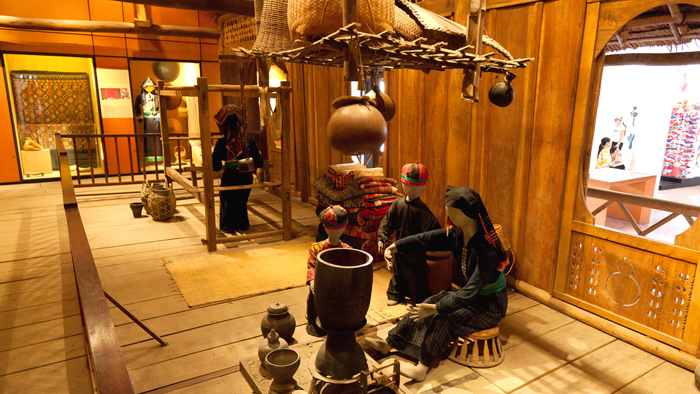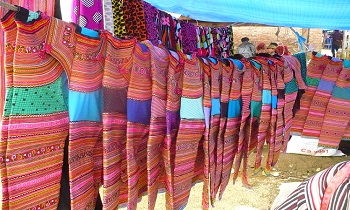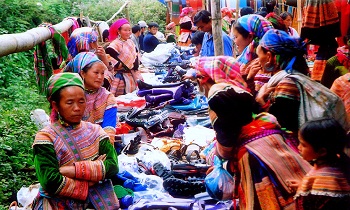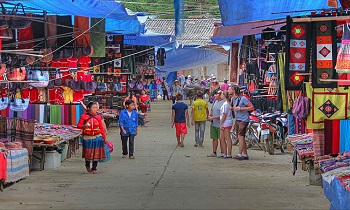
Sapa museum-a must-visit spot for those who are passionate about Sapa’s history and culture
A museum may not be the top choice of people coming to Sapa, but if you are a history and culture explore, Sapa museum is genuinely worth half an hour of your time.
Do not hesitate to visit Sapa museum and get marvelous moments. Take a Sapa group tour to get more information about how to go Sapa and where to go in Sapa.
What does Sapa museum have?
Being in operation since 2007, Sapa museum in the campus of Sapa Information and Promotion of Tourism Center is a successive model of cooperation between Lao Cai province and Aquitaine region of France.
It is the ideal place for anyone to learn about the over-100-year history of this beautiful town, as well as discover the productive labor and religious life, cultural values of ethnic minorities in Sapa.
If you are passionate about exploring how many ethnic tribes there are in Sapa, where they inhabit, or how to identify these groups through their outfits, visiting Sapa museum is a must for you.

Things displayed in the museum
The history of Sapa
In Sapa museum, visitors can get a useful intensive course in the field of the ethnology of the area with several exhibits intended for the patchwork of minority groups living in Sapa.
Sapa museum which is evaluated to be informative also charts the evolution of this highland town from the French colonial period to the present day.
The museum with a unique stilt house is the residence of about 200 precious objects and various materials, publications and models of living standards, beliefs, and customs of ethnic tribes in Sapa.
Coming to the museum, you will take a chance to contemplate the panoramic picture of cultural life, religious values, community activities and the unique ancient outfits of the Hmong, Red Dao, Day, Ha Nhi, and Xa Pho.
Customs and life of the ethnic
The downstairs is the exhibition about the customs and crafts of the H'Mong and Red Dao communities.
This zone concentrates explicitly on their handicrafts as an essential part of the Sapa Fair Craft project to promote these traditional crafts and help offer new economic opportunities for the local ethnic minorities.
Local products and specialties for sale
Entrance is free, but there are several stalls located inside, so tourists may end up paying more than their expectations since actually hard to ignore the lovely brocade handicraft items made by the skillful hand of the ethnic artists here.
You can get some for your souvenirs or buy ones as the gift for your relatives in your hometown. They will be undoubtedly pleasant.

Sapa museum
Arts of Sapa
Moreover, the first floor of the museum also displays lots of handcrafted artwork holding bold traditional identity as reminders of a good time of fine arts in Sapa.
Additionally, visitors can learn the customs of the communities or observe the typical houses of each tribe, the daily objects, and jewelry collections of the ancient human through the animated simulation.
A static exhibition on upstairs will help visitors runs uninspiringly through Sapa's history before moving on to some slightly more appealing displays of the culture of the ethnic groups.
Although some descriptions have been too faded to read, in general, the Sapa museum succeeds in demonstrating the difference between various ethnic tribes in Sapa.
Sapa museum reasonably resembles the Women's Museum or the Ethnology Museum in Hanoi, but far smaller.
Visiting Sapa Museum, tourists can't help admiring the creativity and meticulousness of the artists here, and will also be excited and fascinated by the culture, traditions, and customs of the ancients.
Although urbanization has spread to this remote area, Sapa's traditions and identity are still maintained. The museum is significant to serve the needs of research and exhibits of Sapa nature, history, and culture in the process of construction and development.
How to get there?
Sapa museum is located on the hill, opposite the Stone church, and halfway between Fansipan and Silver waterfall. The exact address is Thach Son street, Sapa downtown.
Like anywhere in the downtown, Sapa museum can be reached on foot. Sapa central town is small enough that tourists are not likely to get lost. However, a basic map will be helpful to most visitors.
Another option is to rent a motorbike in the touristy parts of the town. It may cost $3–6 depending on the duration you like to rent and your bargaining skills as well.

The space in the museum
Insider tips
-
There is a large shop selling the beautiful crafted embroidered indigo-dyed hemp products and the local packaged specialties such as coffee, honey, and spices. You should carry cash just in case you want to purchase something.
-
If you wish to take pictures, ask for permission.
-
If you travel with your children, you should keep eyes on them to avoid them running around.
-
The suggested duration is 30 minutes-1 hour.
Sapa is a symbol of the beauty that Mother Nature has blessed. Annually, a large volume of tourists pulls together here to travel, enjoy the fanciful atmosphere of shimmering mist, and experience the feeling of walking in the drifting clouds. Today, tourists have another fantastic spot to experience the distinctive local culture here - Sapa museum. Let’s explore and have a memorable trip here. Thank you.









